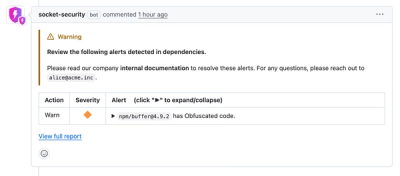
Security News
Crates.io Users Targeted by Phishing Emails
The Rust Security Response WG is warning of phishing emails from rustfoundation.dev targeting crates.io users.
Implements the hashids algorithm in python. For more information, visit http://hashids.org/
A python port of the JavaScript hashids implementation. It generates YouTube-like hashes from one or many numbers. Use hashids when you do not want to expose your database ids to the user. Website: http://www.hashids.org/
hashids is tested with python 2.7 and 3.5–3.8. PyPy and PyPy 3 work as well.
.. image:: https://travis-ci.org/davidaurelio/hashids-python.svg?branch=master :target: https://travis-ci.org/davidaurelio/hashids-python
================== ============== hashids/JavaScript hashids/Python
v0.1.x v0.8.x v0.3.x+ v1.0.2+ ================== ==============
The JavaScript implementation produces different hashes in versions 0.1.x and 0.3.x. For compatibility with the older 0.1.x version install hashids 0.8.4 from pip, otherwise the newest hashids.
Install the module from PyPI, e. g. with pip:
.. code:: bash
pip install hashids pip install hashids==0.8.4 # for compatibility with hashids.js 0.1.x
The tests are written with pytest <http://pytest.org/latest/>_. The pytest module has to be installed.
.. code:: bash
python -m pytest
Import the constructor from the hashids module:
.. code:: python
from hashids import Hashids hashids = Hashids()
Encode a single integer:
.. code:: python
hashid = hashids.encode(123) # 'Mj3'
Decode a hash:
.. code:: python
ints = hashids.decode('xoz') # (456,)
To encode several integers, pass them all at once:
.. code:: python
hashid = hashids.encode(123, 456, 789) # 'El3fkRIo3'
Decoding is done the same way:
.. code:: python
ints = hashids.decode('1B8UvJfXm') # (517, 729, 185)
Hashids supports salting hashes by accepting a salt value. If you don’t want others to decode your hashes, provide a unique string to the constructor.
.. code:: python
hashids = Hashids(salt='this is my salt 1') hashid = hashids.encode(123) # 'nVB'
The generated hash changes whenever the salt is changed:
.. code:: python
hashids = Hashids(salt='this is my salt 2') hashid = hashids.encode(123) # 'ojK'
A salt string between 6 and 32 characters provides decent randomization.
By default, hashes are going to be the shortest possible. One reason you might want to increase the hash length is to obfuscate how large the integer behind the hash is.
This is done by passing the minimum hash length to the constructor. Hashes are padded with extra characters to make them seem longer.
.. code:: python
hashids = Hashids(min_length=16) hashid = hashids.encode(1) # '4q2VolejRejNmGQB'
It’s possible to set a custom alphabet for your hashes. The default alphabet is 'abcdefghijklmnopqrstuvwxyzABCDEFGHIJKLMNOPQRSTUVWXYZ1234567890'.
To have only lowercase letters in your hashes, pass in the following custom alphabet:
.. code:: python
hashids = Hashids(alphabet='abcdefghijklmnopqrstuvwxyz') hashid = hashids.encode(123456789) # 'kekmyzyk'
A custom alphabet must contain at least 16 characters.
The primary purpose of hashids is to obfuscate ids. It's not meant or tested to be used for security purposes or compression. Having said that, this algorithm does try to make these hashes unguessable and unpredictable:
There are no repeating patterns that might show that there are 4 identical numbers in the hash:
.. code:: python
hashids = Hashids("this is my salt") hashids.encode(5, 5, 5, 5) # '1Wc8cwcE'
The same is valid for incremented numbers:
.. code:: python
hashids.encode(1, 2, 3, 4, 5, 6, 7, 8, 9, 10) # 'kRHnurhptKcjIDTWC3sx'
hashids.encode(1) # 'NV' hashids.encode(2) # '6m' hashids.encode(3) # 'yD' hashids.encode(4) # '2l' hashids.encode(5) # 'rD'
This code was written with the intent of placing generated hashes in visible places – like the URL. Which makes it unfortunate if generated hashes accidentally formed a bad word.
Therefore, the algorithm tries to avoid generating most common English curse words by never placing the following letters next to each other: c, C, s, S, f, F, h, H, u, U, i, I, t, T.
MIT license, see the LICENSE file. You can use hashids in open source projects and commercial products.
FAQs
Implements the hashids algorithm in python. For more information, visit http://hashids.org/
We found that hashids demonstrated a healthy version release cadence and project activity because the last version was released less than a year ago. It has 1 open source maintainer collaborating on the project.
Did you know?

Socket for GitHub automatically highlights issues in each pull request and monitors the health of all your open source dependencies. Discover the contents of your packages and block harmful activity before you install or update your dependencies.

Security News
The Rust Security Response WG is warning of phishing emails from rustfoundation.dev targeting crates.io users.

Product
Socket now lets you customize pull request alert headers, helping security teams share clear guidance right in PRs to speed reviews and reduce back-and-forth.

Product
Socket's Rust support is moving to Beta: all users can scan Cargo projects and generate SBOMs, including Cargo.toml-only crates, with Rust-aware supply chain checks.